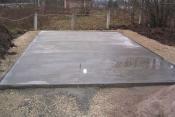Search
Login
Recommended
Repair and installation of an endova on a roof from a soft tile
The junction of two roof slopes forms an internal angle at which a metal apron (endova) is installed, which prevents the penetration of moisture from precipitation. This is the most vulnerable place, as well as the place where the roof joins the pipe, leaks often occur and roof repairs are required.
Content
- Types of Ends
- Tools for work
- Preparing a place for repair (analysis of the old flooring)
- Installing a waterproofing membrane
- Mounting the apron video
- Reconstruction of the disassembled roof
Types of Ends
Draining aprons, or valleys, produce two forms: V-shaped and W-shaped.
W-shaped drainage valleys are considered more efficient and convenient in use, they serve a longer time. This is confirmed by large construction companies, motivating by the fact that a longitudinal ridge in the middle of the valley prevents water from flowing under the shingles of the soft roof on its opposite side.
In addition, the crest of the W-shaped valley serves as a compensator for thermal deformations. The metal heats up in the sun, moves, and this crest reduces warpage and the valley works better with its shape.
The crest of the W-shaped valley gives the metal apron quite substantial strength and reduces the deformation of metal aprons during transportation.
Tools for work
The tools necessary for disassembling the roof, installing an endova with waterproofing and subsequent restoration of the roof play a significant role, since the quality of the repair depends on how qualitatively the analysis of the old roof takes place, which then needs to be put in place.
Experts advise you to have the following tools at hand: a special knife with a hook at the end and a removable blade - it is convenient to work with such a knife when cutting shingle shingles directly at the repair site.
For work, a special roofing hatchet is needed: it must have a heavy flat edge, i.e. It can also be used as a hammer. The handle should not be particularly long so that you can swing in an uncomfortable, narrow place. The roofer's crowbar should be correctly bent in place of the shank, the crowbar should pull out the nails with the help of which shingles are fastened.
Edgeband - a tool for bending the edges.
Professionals advise using a tool from Estwing.
In addition to the above tools, you need a foam rubber mat 600x1000 mm. The mat has a non-slip surface, it is convenient to kneel on it, sit or unfold the instrument. The mat is able to protect shingles from damage during the repair of the roof.
Preparing a place for repair (analysis of the old flooring)
When laying soft bituminous tiles, two methods of laying shingles are usually used: overlap and weaving. In both cases, the shingles are always removed from top to bottom.
If the shingles are laid by the weaving method - during parsing, both sides of the floor are disassembled at the same time.
If the roof is covered with an overlap: initially the shingles are removed along the entire height of the covering part of the ramp, then the opposite side is dismantled.
In the warm season, the repair work must begin in the very early morning, at sunrise, the work must be done quickly, since the shingles of the soft tiles are glued together.
In the morning, while they are still cold, they can be relatively easily separated from each other. When the sun warms up the roof, it is almost impossible to separate the old shingles.
Professionals say that it’s pretty easy to dismantle a roof of 25-30 years using the above tools.
If the roof is old enough, within 40-50 years, the shingles seem to grow together and it is impossible to disconnect them without damage.
With the help of a roofing hatchet and the sharp end of a crowbar, the old roofing is removed from the top row.
The bottom edge of the row is gently lifted above the first shingle to be removed.
With a crowbar, all nails are removed not only from the shingle that needs to be removed, but also the nails of the next upper row of shingle.
Having removed the first row, further work goes quickly, but it is necessary to act carefully so as not to damage the roof shingles.
If removable shingles are intended to be used in the future, they are neatly laid in accordance with the location on the roof.
After removing all the intended shingles, the exposed part of the roof is cleaned of debris, checked for damage and non-pulled nails.
Installing a waterproofing membrane
Before installing the valley, the junction of the two roofs must be closed with a self-adhesive waterproofing membrane.
3. waterproof membrane
The waterproofing must be installed quickly, since there is glue at the edges of the membrane and as the atmosphere rises, it becomes more sticky.
If only one person works on the roof, then the membrane in the valley of the valley is spread with short, overlapping segments, the length of which is 2.5 meters.
The segments are laid from the bottom up, the overlap at the joints up to 150 mm.
So that the slippery membrane does not slip, the upper end is seized with roofing nails, after laying a piece of waterproofing, the film is removed first on one side and carefully brought under the adjacent roof shingles, after that, the edge of the membrane is pressed tightly.
Then, in the same way, they start a membrane film under the shingles of the opposite side of the flooring.
Gradually, rising from bottom to top, waterproofing is laid along the entire length of the valley.
The upper edge of the membrane is wound under a series of shingles of soft tiles that remained on the roof.
Mounting the apron
At the top of the membrane, at the junction, a W-shaped drainage apron (endova) is laid.
The method of laying a metal valley is similar to the installation of a waterproofing membrane, namely: the sides and the upper edge of the valley are brought under shingles. The lower edge of the metal valley is cut along the overhang of the roof with an allowance of 25-30 mm. Later, this allowance must be bent down so that the flowing water gets into the gutter. Using a manual hemmer, the bend is smooth and accurate.
If the length of the valley is more than 3 meters, then it is better to mount it from several sections 2-2.5 meters long.
It is very important to install the endov sections strictly on one straight line, this will prevent the problem of laying shingles of soft tiles when restoring the disassembled part of the roof. To get the correct straight line, a long cord is stretched from the bottom to the very top of the valley, a reference point for aligning individual sections.
After laying, the endov sections are fastened with nails, during fastening they retreat from the lateral edges by 25-30 mm., The fastening step is 250-300 mm.
Reconstruction of the disassembled roof
The main and difficult work is done, now it is necessary to restore the old roof.
The guides for laying the shingles are the rows of tiles preserved on the slopes of the roof.
Roof tile shingles are laid first on one side along its entire height, and then tile shingle roofs are laid on the second side.
The shingles are laid so that they with a margin overlap the center of the center line of the valley.
The shingles are fastened with nails, but the nails should not pierce the metal of the apron.
Ideally, the extreme row of shingles is fastened with nails at a distance of 25-30 mm. from the edge of the apron.
For convenience, the fastening line can be repelled with a deliberate cord along the entire length of the valley.
At the end of laying the shingles on the one hand, they are cut, the corners of the shingles are cut, while there remains a small clearance for water flow, it is desirable that this clearance widens to the bottom of the valley.
If soft shingles are restored with old shingles, it is necessary to restore the adhesive layer of the tiles on the back side, i.e. it is necessary to grease these places with bituminous sealant.





